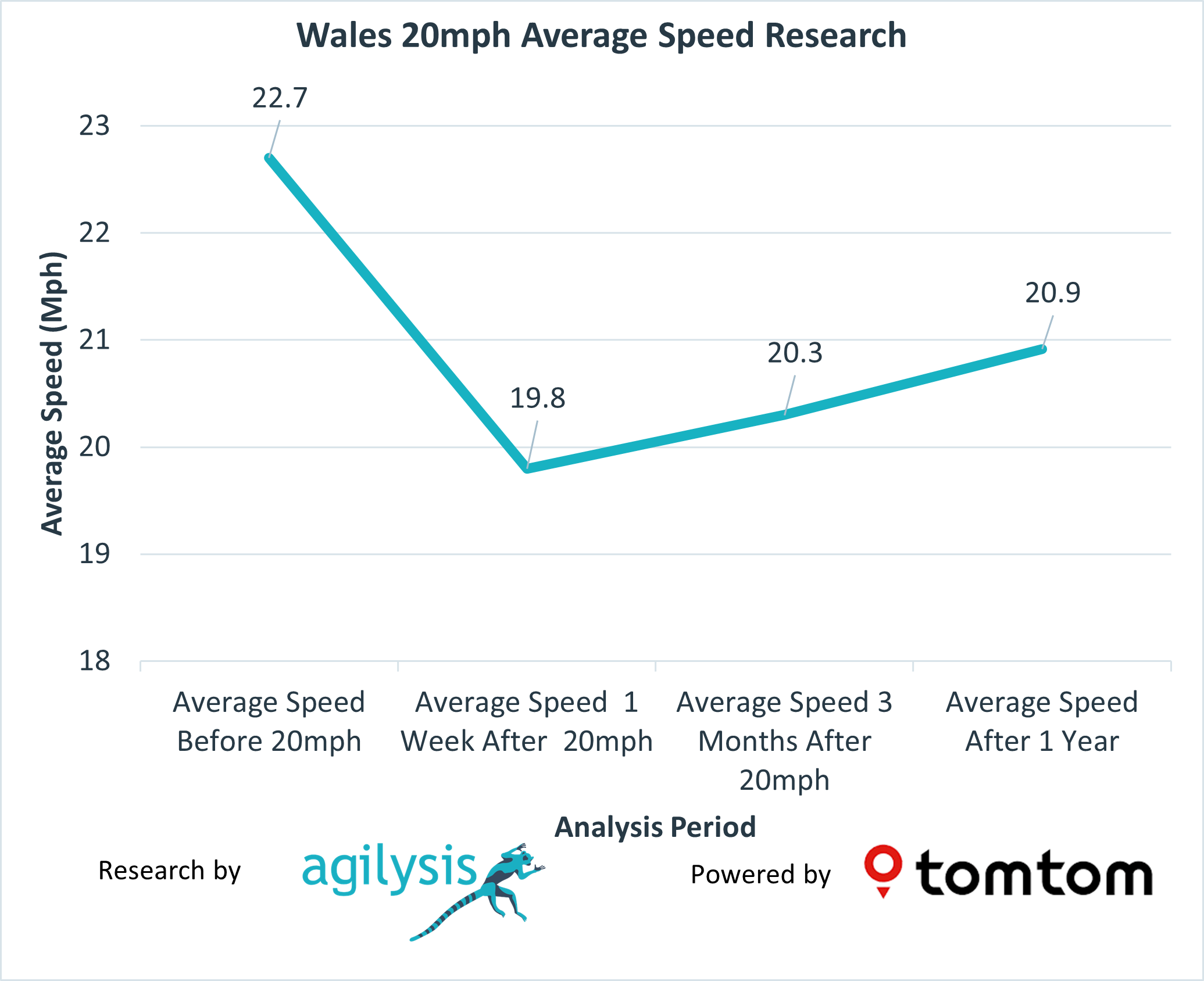
A year on from the change in the default urban speed limit across Wales we have once again worked with TomTom to review changes in driver behaviour by reviewing speeds on almost 500km of roads across the country. Our initial, ground-breaking analysis showed that measured speeds dropped from an average of 22.7mph down to 19.8mph in the analysis period immediately after the change. Following publication of the results there has been considerable debate about the policy, implementation, and long-term benefits. We are hoping to add to the available evidence base by re-running our analysis to see what is happening now.
Agilysis have now undertaken another, independent analysis of vehicle speeds on the same roads as studied in the previous analysis to see what the impact has been one year after the change. As well as updating the headline data, this report also reviews which types of roads have seen the greatest change in speeds by reviewing impact based on previous speeds in one mile per hour bands.
What do the latest results show?
Vehicles speeds remain lower than before the change in the limit but they have bounced back a little, now sitting 1.1mph higher than in the week immediately after the change. Speeds are still down by 1.8mph using our reference data, and this means that on the roads we samples, average speeds are 20.9mph.
An analysis of changes in vehicle speeds by location has also been included in the report. Although the road lengths are lower, and attract lower sample sizes, they do demonstrate significant differences in speed reductions and residual average speeds. Merthyr Tydfil has the lowest reduction in speeds (0.3mph) with Rhyl & Prestatyn seeing the greatest reduction. The average speed values in September 2024 across the sample areas in Wales are 20.9mph with fluctuations of around 1mph in individual areas.
Revealing which roads saw the greatest change in speeds
In this research update we have chosen to look at how speeds have changed relative to the pre-implementation speed in 1mph increments or bands. As expected, roads where speeds were already below 20mph show little or no change, and the greatest reduction appears to be in the range of 25-30mph. Beyond this, roads with much higher pre-implementation speeds, results are less pronounced.
Understanding this phenomenon requires further analysis and review of individual roads and their characteristics including traffic volumes, pre-existing free-flow traffic levels (congestion), and proximity to speed limit changes. We hope to conduct further research in this area in future and welcome conversations with those interested in the topic. Agilysis are already speaking to several road authorities in great Britain about the potential to carry out in-depth research in other places where speed limits have been changed.
What does this mean for Wales and, potentially, the rest of the world?
As we reach the first anniversary of the change in limits across Wales, this seems like the appropriate time to review performance on individual roads and consider what further interventions are required. The power and availability of new data sources affords opportunities for local authorities and police forces to have a greater understanding of vehicle speeds across road network, either post-implementation of speed limit change or before new limits are put in place. This is critical in addressing specific issues at certain high-risk locations.
Our CEO, and report author, Richard Owen, will be unveiling these results live on Friday 20th September 2024 at the City Flows Event in Trento, Italy. 17 international experts , administrators and administrators will meet to analyse the impacts of lowering speed limits in urban centres on four main aspects: safety , environment , local economy and health . The event is organized by Fondazione Unipolis and the European Transport Safety Council with free online registration for streamed coverage available here - https://www.eventbrite.it/e/biglietti-city-flows-964965386447?aff=erelexpmlt


